Glad to See We Are All Alive - Welcome to the 5th World
by Mitch Battros -

Earth Changes Media The Hard Science of Maya's Prediction of "Transition" What you about to read side-steps the woo-woo surrounding a single date of December 21st 2012 in which many believed dramatic events would occur and half the world would be swept away. However - I must say that over the past four or five months a majority of people were better able to put things in perspective and even some came to their realization that Dec. 22nd 23, 24' and so on.... would probably be no different than the magical date of the 21st
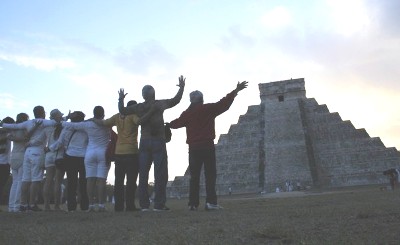
I believe credit is due to those who helped people better understand
Maya's message. In fact, you should not be surprised to hear that the
people most upset about all this Hollywood style propaganda are the
Mayan elders themselves. At first the elders really tried to get
interested people to understand what the 'transition' is meant to be and
to provide a way to give some form of tangible pathway. But when
venturing into the celestial world of less defined understanding in the
principles of quantum physics, dark matter, and ether - one can easily
sympathize with the majority of people who become frustrated with not
being able to interpret the Mayan message.
Most of us want to know what it looks like - How will I feel? - Will my
family and friends notice something different? And the biggest one: "How
long will it take, a minute, a day, a month, a year? Did I miss it?
Today's society has adjusted to time of 'instant resolve'. If you want
to understand something.... just Google it. If want to travel to an
unknown area....just GPS it. If you need to contact someone....just cell
phone it. If they are far away in another country....just Skype it.
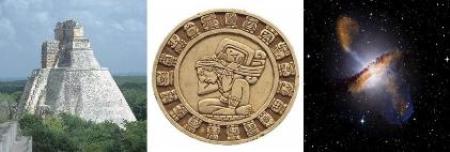
So how could the Mayan people have gained such empirical knowledge
without the advanced technology of today? The Answer: Because their
tribe has been on Earth for several millennia. On 'millennia' equals
1,000 years. It is believed the Maya and related indigenous tribes have
survived for perhaps 30,000+ years. Long enough to witness "long-term"
cycles - then pass this knowledge to the next generation and repeated
for over 400 generations. In North America for example - our culture has
been established for less than 238 years with the average person
learning and experiencing for less than 2 generations. Because of our
high technology we have developed a short attention span often speaking
of trends lasting one month, one year, and even in the science community
the average time span of researched data is only 127 years.
In short - the Mayan calendar identifies the beginning and end of
long-term and shorter-term cycles. There is no understanding of a moment
in time - as in a single day such as Dec. 21st 2012. The 'transition'
from one state of being to another "does not" fit the mechanics like
flipping on a switch. It is a gradual process of which scientific
agencies such as NASA and ESA identify the galactic alignment factually
occurred in 2009. However, other researchers believe the 'transition'
period of this cycle (5th World or 5th Sun) began in 1980 and has an
approximate 36 year precession.
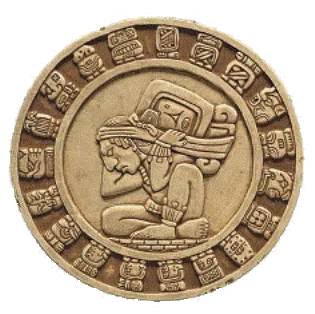
The Mayan calendar is made up of three cyclical counts. The first is
known as the 'sacred calendar' or Tzolk'in, which lasts 260 days and
then started over again. The second calendar is known as the Haab', or
secular calendar, which lasts 360 days but did not account for the extra
quarter-day it takes the Earth to revolve around the Sun. The final and
3rd calendar is known as the B'ak'tun, or long count calendar, which
lasts 144,000 days which is approximately 400 years (using a 360 day
seasonal count). Dec. 21st 2012 marked the end of the "13th B'ak'tun" -
a period of approximately 5125.36 years. This period is known as the
'Great Cycle' or the (World Cycle). It is the time when all period
cycles (or sub-cycles) have completed. It is the end of one full
'transition' and the beginning of another.

The Mayan message as set by their calendar indicates we are in
'transition' from the 4th World into the 5th World (or 5th Sun). They
also predicted we are going beyond the 4 known elements of
Earth-Wind-Water-Fire and ushering in the 'New' Element or '5th
Element'. This New or 5th Element is "Ether". The definition of 'ether'
described in various dictionaries such as Webster and Cambridge: "It is
a theoretical substance which occupy all space, postulated to account
for the propagation of electromagnetic radiation through the universe."
Mayan prophecy speaks of 'celestial events' as mentioned in the Mayan
Sacred Books of 'Chilam Balam' and 'Popol Vuh' to occur at the end of
the 4th world and beginning of the 5th world. We are in that time right
now.
Related Article:
The Transition from the 4th World to the 5th World

The correlation to new scientific discoveries of charged particles fits
Mayan prophecy of both "Ether" and "Celestial Events". Science confirms
the source of dark matter or dark energy is made up of charged particles
such as galactic cosmic rays, gamma rays, and solar x-rays. In other
words - it is "Ether" which binds all things together.
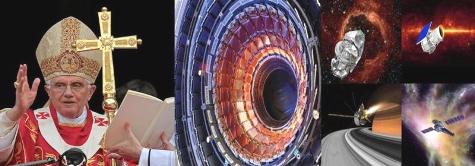
In November 2011, Pope Benedict XVI summoned all scientific leaders from
around the world in the fields of astro-astronomy, particle physics, and
quantum physics to the Vatican. The main discussion was on the so-called
"god particle" - otherwise known as the Higgs boson particle.
The Higgs boson or Higgs particle (or god particle) is an elementary
particle whose possible discovery was announced on July 4, 2012. It was
predicted by a theory in physics called the Standard Model. It is one of
the 17 fundamental particles in the Standard Model. The other 16 are the
6 quarks, 6 leptons, the photon, gluon, W, and Z bosons. The quarks and
leptons are examples of a class of particles called fermions. They are
the ones that make up all the everyday matter we see around us. The
photon, W, Z, gluon, and Higgs particles are in a different class called
bosons. They are the ones responsible for all the forces in nature
except gravity. Scientists don't yet know how to combine gravity with
the Standard Model.
Related Article:
Ancient Tribes, Religion, Spirit, Scientifically United
Now the Good, the Bad, and the Woo-Woo of 2012
December 21st 2012 started out as the prophetic day some had believed
would usher in the fiery end of the world. By Friday afternoon, it had
become more comic than cosmic, the punch line of countless Facebook
posts and at least several dozen T-shirts.
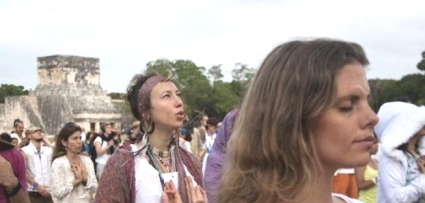
At the ruins of the ancient Mayan city of Chichen Itza, thousands
chanted, danced and otherwise frolicked around ceremonial fires and
pyramids to mark the conclusion of a vast, 5,125-year cycle in the Mayan
calendar. The doomsayers who had predicted apocalypse were nowhere to be
seen. Instead, people showed up in T-shirts reading "The End of the
World: I Was There." Vendors eager to sell their ceramic handicrafts and
wooden masks called out to passing visitors, "Buy something before the
world ends."
For the masses in the ruins, Dec. 21 sparked celebration of what they
saw as the birth of a new and better age. It was also inspiration for
massive clouds of patchouli and marijuana smoke and a chorus of conch
calls at the break of dawn. The official crowd count stood at 20,000 as
of mid-afternoon, with people continuing to arrive. That surpassed the
count on an average day but not as many as have gathered at the ruins
during equinoxes.
The boisterous gathering Friday included Buddhists, pagan nature
worshippers, druids and followers of Aztec and Maya religious
traditions. Some kneeled in attitudes of prayer, some seated with arms
outstretched in positions of meditation, all facing El Castillo, the
massive main pyramid. Ceremonies were being held at different sides of
the pyramid, including one led by a music group that belted out American
blues and reggae-inspired chants. Others involved yelping and shouting,
and drumming and dance, such as one ceremony led by spiritual master
Ollin Yolotzin. "The world was never going to end, this was an invention
of the mass media," said Yolotzin, who leads the Aztec ritual dance
group Cuautli-balam. "It is going to be a good era. ... We are going to
be better."
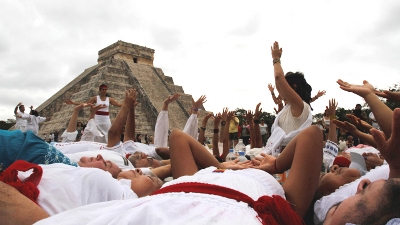
Ivan Gutierrez, a 37-year-old artist who lives in the nearby village,
stood before the pyramid and blew a low, sonorous blast on a conch horn.
"It has already arrived, we are already in it," he said of the new era.
"We are in a frequency of love; we are in a new vibration." But it was
unclear how long the love would last: A security guard quickly came over
and asked him to stop blowing his conch shell, enforcing the ruin site's
ban on holding ceremonies without previous permits.
Similar rites greeted the new era in neighboring Guatemala, where Mayan
spiritual leaders burned offerings and families danced in celebration.
Guatemalan President Otto Perez Molina and Costa Rican President Laura
Chinchilla attended an official ceremony in the department of Peten,
along with thousands of revelers and artists. At an indigenous South
American summer solstice festival in Bolivia, President Evo Morales
arrived on a wooden raft to lead a festival that made offerings to
Pachamama, Mother Earth, on a small island in the middle of Lake
Titicaca.
The leftist leader and 3,000 others, including politicians, indigenous
shamans and activists of all stripes, didn't ponder the end of the
world, just the death of the capitalist system, which Morales told the
crowd had already happened amid "a global financial, political and moral
crisis." "The human community is in danger because of climatic reasons,
which are related to the accumulation of wealth by some countries and
social groups," he told the crowd. "We need to change the belief that
having more is living better."
Despite all the pomp, no one is certain the period known as the Mayas'
13th Baktun officially ended Friday. Some think it may have happened at
midnight. Others looked to Friday's dawn here in the Maya heartland.
Mexico's National Institute of Anthropology and History even suggested
historical calculations to synchronize the Mayan and Western calendars
might be off a few days. It said the Mayan Long Count calendar cycle
might not really end until Sunday.
One thing, however, became clear to many by Friday afternoon: The world
had not ended.
John Hoopes, an assistant professor of anthropology at the University of
Kansas, was at the ruins, using the opportunity to talk about how myths
are created. "You don't have to go to the far corners of the earth to
look for exotic things, you've got them right here," he noted.
End-of-the-world paranoia, however, has spread globally despite the
insistence of archeologists and the Maya themselves that the date meant
no such thing.
Dozens of schools in Michigan canceled classes this week amid rumors of
violence tied to the date. In France, people expecting doomsday were
looking expectantly to a mountain in the Pyrenees where they believe a
hidden spaceship was waiting to spirit them away. And in China,
government authorities were cracking down on a fringe Christian group
spreading rumors about the world's end, while preaching that Jesus had
reappeared as a woman in central China.
Gabriel Romero, a Los Angeles-based spiritualist who uses crystal skulls
in his ceremonies, had no such illusions as he greeted the dawn at
Chichen Itza. "We'll still have to pay taxes next year," he said. As if
to put the final nail in the coffin of such rumors, Bob McMillan of the
University of Arizona's Lunar and Planetary Laboratory confirmed Friday
that no large asteroids are predicted to hit anytime soon. And Bill
Leith, a senior science adviser at the U.S. Geological Survey, noted
that as far as quakes, tsunamis and solar storms for the rest of the
day, "we don't have any evidence that anything is imminent."
Still, there were some who wouldn't truly feel safe until the Sun sets
Friday over the pyramids in the Yucatan peninsula, the heartland of the
Maya. Mexico's best-known seer, Antonio Vazquez Alba, known as "El Brujo
Mayor," said he had received emails with rumors that a mass suicide
might be planned in Argentina. He said he was sure that human nature
represented the only threat Friday. "Nature isn't going to do us any
harm, but we can do damage to ourselves," he said.
Authorities worried about overcrowding and possible stampedes during
celebrations Friday at Mayan sites such as Chichen Itza and Uxmal, both
about 1 1/2 hours from Merida, the Yucatan state capital. Special police
and guard details were assigned to the pyramids. Yucatan Gov. Rolando
Zapata said he for one felt the growing good vibes, and not just because
his state was raking in loads of revenue from the thousands of
celebrants flooding in. "We believe that the beginning of a new baktun
means the beginning of a new era, and we're receiving it with great
optimism," Zapata said.
Mitch Battros
Producer - Earth Changes Media
Email: newsletter@earthchangesmedia.com
Earth Changes Media Newsletter